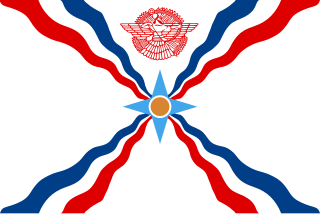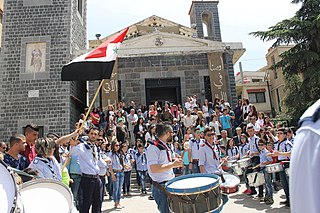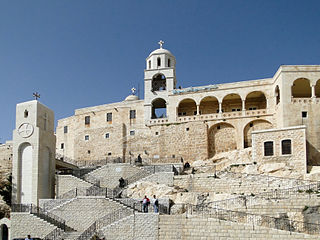
This is a demography of the population of Lebanon including population density, education level, health of the populace, economic status, religious affiliations and other aspects of the population.

Eastern Christianity comprises Christian traditions and church families that originally developed during classical and late antiquity in Eastern Europe, Southeastern Europe, Asia Minor, the Caucasus, Northeast Africa, the Fertile Crescent and the Malabar coast of South Asia, and ephemerally parts of Persia, Central Asia, the Near East and the Far East. The term does not describe a single communion or religious denomination.

Assyrians are an indigenous ethnic group native to Assyria, a geographical region in Western Asia. Modern Assyrians descend from their ancient counterparts, originating from the ancient indigenous Mesopotamians of Akkad and Sumer, who first developed the civilisation in northern Mesopotamia that would become Assyria in 2600 BCE. Assyrians have been speaking dialects of Suret, a Semitic language of the Neo-Aramaic branch, since approximately 1000 BCE. Modern Assyrians may culturally self-identify as Syriacs, Chaldeans, or Arameans for religious, geographic and tribal identification.

Arab Christians are ethnic Arabs, Arab nationals, or Arabic-speakers who adhere to Christianity. The number of Arab Christians who live in the Middle East is estimated to be between 10 and 15 million. Arab Christian communities can be found throughout the Arab world, but are concentrated in the Eastern Mediterranean region of the Levant and Egypt, with smaller communities present throughout the Arabian Peninsula and North Africa.

The phenomenon of large-scale migration of Christians is the main reason why Christians' share of the population has been declining in many countries. Many Muslim countries have witnessed disproportionately high emigration rates among their Christian minorities for several generations. Today, most Middle Eastern people in the United States are Christians, and the majority of Arabs living outside the Arab World are Arab Christians.

The Lebanese people are the people inhabiting or originating from Lebanon. The term may also include those who had inhabited Mount Lebanon and the Anti-Lebanon Mountains prior to the creation of the modern Lebanese state. The major religious groups among the Lebanese people within Lebanon are Shia Muslims (27%), Sunni Muslims (27%), Maronite Christians (21%), Greek Orthodox Christians (8%), Melkite Christians (5%), Druze (5.2%), Protestant Christians (1%). The largest contingent of Lebanese, however, comprise a diaspora in North America, South America, Europe, Australia and Africa, which is predominantly Maronite Christian.

The Catholic Church in Lebanon is part of the worldwide Catholic Church under the spiritual leadership of the Pope in Rome.

Christianity in Lebanon has a long and continuous history. Biblical Scriptures purport that Peter and Paul evangelized the Phoenicians, whom they affiliated to the ancient patriarchate of Antioch. The spread of Christianity in Lebanon was very slow where paganism persisted especially in the mountaintop strongholds of Mount Lebanon. A 2015 study estimates some 2,500 Lebanese Christians have Muslim ancestry, whereas the majority of Lebanese Christians are direct descendants of the original early Christians.

Christians in Syria make up about 10% of the population. The country's largest Christian denomination is the Greek Orthodox Church of Antioch, closely followed by the Melkite Greek Catholic Church, an Eastern Catholic Churches that shares its roots with the Eastern Orthodox Church of Antioch, and then by Oriental Orthodox Churches such as Syriac Orthodox Church and Armenian Apostolic Church. There are also a minority of Protestants and members of the Assyrian Church of the East and Chaldean Catholic Church. The city of Aleppo is believed to have the largest number of Christians in Syria. In the late Ottoman rule, a large percentage of Syrian Christians emigrated from Syria, especially after the bloody chain of events that targeted Christians in particular in 1840, the 1860 massacre, and the Assyrian genocide. According to historian Philip Hitti, approximately 900,000 Syrians arrived in the United States between 1899 and 1919. The Syrians referred include historical Syria or the Levant encompassing Syria, Lebanon, Jordan and Palestine. Syrian Christians tend to be relatively wealthy and highly educated.

The Christians of Iraq are considered to be one of the oldest continuous Christian communities in the world. The vast majority of Iraqi Christians are indigenous Eastern Aramaic-speaking ethnic Assyrians who claim descent from ancient Assyria, and follow the Syriac Christian tradition. Some are also known by the name of their religious denomination as well as their ethnic identity, such as Chaldo-Assyrians, Chaldean Catholics or Syriacs. Non-Assyrian Iraqi Christians are largely Arab Christians and Armenians, and a very small minority of Kurdish, Shabaks and Iraqi Turkmen Christians. Most present-day Iraqi Christians are ethnically, linguistically, historically and genetically distinct from Kurds, Arabs, Iranians, Turks and Turkmens. Regardless of religious affiliation the Eastern Aramaic speaking Christians of Iraq and it's surrounds are one genetically homogeneous people. They identify themselves as being a separate people, of different origins and with a distinct history of their own harking back to ancient Assyria and Mesopotamia. Christian Assyrians also have communities in northeastern Syria, southeastern Turkey, and northwestern Iran as well as in the wider worldwide Assyrian diaspora.

Christianity has been, historically, a Middle Eastern religion with its origin in Judaism. Eastern Christianity refers collectively to the Christian traditions and churches which developed in the Middle East, Egypt, Asia Minor, the Far East, Balkans, Eastern Europe, Northeastern Africa and southern India over several centuries of religious antiquity. It is contrasted with Western Christianity, which developed in Western Europe. As a historical definition the term relates to the earliest Christian communities and their long-standing traditions that still exist.

Assyrians in Lebanon are people of Assyrian descent living in Lebanon. It is estimated that there are approximately 30,000 Assyrians currently residing in Lebanon, primarily in Beirut and Zahlé. This number includes the descendants of Assyrian genocide survivors who fled Iraq, Turkey, and Iran between 1915-1934.

Terms for Syriac Christians are endonymic (native) and exonymic (foreign) terms, that are used as designations for Syriac Christians, as adherents of Syriac Christianity. In its widest scope, Syriac Christianity encompass all Christian denominations that follow East Syriac Rite or West Syriac Rite, and thus use Classical Syriac as their main liturgical language. Traditional divisions among Syriac Christians along denominational lines are reflected in the use of various theological and ecclesiological designations, both historical and modern. Specific terms such as: Jacobites, Saint Thomas Syrian Christians, Maronites, Melkites, Nasranis, and Nestorians have been used in reference to distinctive groups and branches of Eastern Christianity, including those of Syriac liturgical and linguistic traditions. Some of those terms are polysemic, and their uses have been a subject of terminological disputes between different communities, and also among scholars.

Assyrian nationalism is a movement of the Assyrian people that advocates for independence or autonomy within the regions they inhabit in northern Iraq, northeastern Syria, northwestern Iran, and southeastern Turkey.

Lebanon is an eastern Mediterranean country that has the most religiously diverse society within the Middle East, comprising 18 recognized religious sects. The primary religions are Islam and Christianity. The Druze are about 5% of the citizens. Outside of Lebanon, Lebanese people are mostly Christians. It is also estimated that a large proportion of its population are refugees, which affects statistics. The refugees, mostly Syrian or Palestinian, are predominantly Sunni but also include Christians and Shia.
All three major Abrahamic religions originated from the Middle East and are present in the Middle East. Islam is the most prevalent religion in the contemporary Middle East.

Christianity, which originated in the Middle East during the 1st century AD, is a significant minority religion within the region, characterized by the diversity of its beliefs and traditions, compared to Christianity in other parts of the Old World. Christians now make up approximately 5% of the Middle Eastern population, down from 20% in the early 20th century. Cyprus is the only Christian majority country in the Middle East, with Christians forming between 76% and 78% of the country's total population, most of them adhering to Eastern Orthodox Christianity. Lebanon has the second highest proportion of Christians in the Middle East, around 40%, predominantly Maronites. Egypt has the next largest proportion of Christians, at around 10% of its total population. Copts, numbering around 10 million, constitute the single largest Christian community in the Middle East.
Religion in Syria refers to the range of religions practiced by the citizens of Syria. Historically, the region has been a mosaic of diverse faiths with a range of different sects within each of these religious communities. The majority of Syrians are Muslims, of which the Sunnis are the most numerous, followed by the Shia groups, and Druzes. In addition, there are several Christian minorities. There is also a small Jewish and Yazidi community.
Semaan is a Christian surname mainly found in the Levant area of the Middle East. It is derived from the Semitic root word/verb sema or shema, which means “to hear”; thus, the meaning of Semaan becomes “the one who hears or listens” in both Syriac Aramaic and Arabic. Its equivalent in Hebrew is שִׁמְעוֹן, which also has the same meaning. The Greek transliteration is Σιμων (Simon) or Συμεών (Symeon), and, when Latinized, it becomes Simon or Simeon.

In 2004, Metro Detroit had one of the largest settlements of Middle Eastern people, including Arabs and Chaldo-Assyrians in the United States. As of 2007 about 300,000 people in Southeast Michigan traced their descent from the Middle East. Dearborn's sizeable Arab community consists largely of Lebanese people who immigrated for jobs in the auto industry in the 1920s, and of more recent Yemenis and Iraqis. In 2010 the four Metro Detroit counties had at least 200,000 people of Middle Eastern origin, excluding Jews. Bobby Ghosh of TIME said that some estimates gave much larger numbers. From 1990 to 2000 the percentage of people speaking Arabic in the home increased by 106% in Wayne County, 99.5% in Macomb County, and 41% in Oakland County.






















